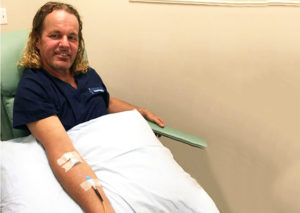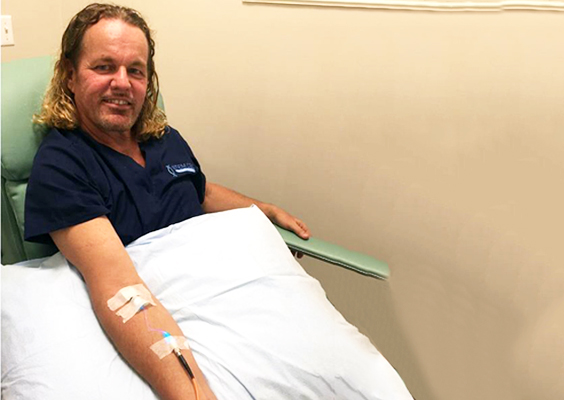As you age, you lose energy.
Everyone feels that, including you.
But knowing where that energy comes from, and how to replace it, means you don’t have to suffer like everyone else does.
If you accept the idea that you can get older and still feel alert and energetic, a whole new world opens up in front of you.
Let me show you what I mean
The secret to solving your “energy crisis,” are the microscopic organelles that live inside your cells.
If you’re a regular reader, you’ve heard me talk about mitochondria. Throughout your whole life, your experience of energy and alertness comes from these tiny power generators.
If you have a lot of them in each cell, and they’re all running at full speed, you feel like you can do anything. You feel capable and in control. You have the world on a string.
But when they drop in number, or start to run down, that’s when you hit a brick wall. That’s when you start taking naps, and feel like you can never get anything done.
Today, I’ll show you a new, hi-tech way of energizing your mitochondria, plus a few simple strategies you can do at home.
Laser Technology Lights Up Your Mitochondria
Recently, I discovered a way to rev up your cellular power stations using a laser. And I know it works, because I tested it on myself at the clinic run by my colleague Dr. Joseph Purita.
He’s one of the leaders in intravenous laser blood therapy. I introduced you to Dr. Purita recently in my letter about his breakthroughs in platelet-rich plasma therapy. He runs the Stem Cell Centers of America in Boca Raton, Florida.
Dr. Purita doesn’t consider himself an anti-aging doctor. He’s more interested in the laser’s ability to kill pathogens
like viruses and bacteria, and how it activates white blood cells.
But lasers energize your mitochondria, too. And that’s how you get the energy boost.
After I got to Dr. Purita’s office, I had a catheter placed in my arm. The tip of the catheter had a tiny bulb that emits a special laser beam.
With the flip of a switch, a pale blue light comes on. The beam glows so cool, it can’t damage any healthy cells. In about 10 minutes, all the blood in my body circulated past the beam.
Suddenly, I felt hyper-alert and brimming with energy. I was more focused and clear-headed than I’ve ever felt in my life.
When I told Dr. Purita, he wasn’t fazed.
“Everyone feels like that.”
This new energy lasted for hours and changed me somehow. I can still feel some of the effect.
Aside from renewed strength and vigor, strong mitochondria mean you can fight off atherosclerosis,1 fibromyalgia, chronic fatigue syndrome,2 diabetes, cardiomyopathy, Alzheimer’s, Parkinson’s,3 and many other diseases that can contribute to your physical and mental decline as you age.4,5,6,7,8
Dr. Purita will be speaking at my Palm Beach Anti-Aging Summit on October 8-9, and I’m looking forward to offering IV laser blood therapy or sometime known as intravenous blood irradiation at my new Palm Beach Institute for Anti-Aging Medicine.
But if you can’t come to my Anti-Aging Institute, you can still fire up your mitochondria at home.
Fire Up Your Mitochondria in 5 Simple Steps
- CoQ10: Feed your mitochondria the best fuel. CoQ10 is like high-octane gasoline. But I recommend ubiquinol, which is a reduced form of CoQ10 that’s 8 times more bioavailable. I’ve been reduced to the level of cellular fuel. I recommend at least 50 mg. a day.
- PQQ: Its full name is pyrroloquinoline quinone, and it triggers your cells to make more mitochondria. In one study, mice grew a staggering number of new mitochondria after they were fed PQQ for eight weeks.9 I recommend 10 mg. a day.
- L-carnosine: Normally, your body uses this biochemical to repair tissues and clear away toxins. But it also increases the energy output of mitochondria. And it can even revive mitochondria and make them better than they were before. I recommend 500 mg. twice a day.10
- Quercetin: Quercetin is a plant pigment found in onions, apples, berries, grapes and red wine. It’s a powerful immune-system booster. And it can help cells grow mitochondria and even protect against toxic stress.11,12,13
- Exercise: Short bursts of intense exertion naturally create more energy producing mitochondria, especially in your heart and brain.15 So my PACE fitness program is ideal for pushing your cells to make more of the tiny power plants.
To your good health,
![]()
Al Sears, MD, CNS
1. Sobenin I, Zhelankin A, Sinyov V, Bobryshev Y, Orekhov A. “Mitochondrial Aging: Focus on Mitochondrial DNA Damage in Atherosclerosis – A Mini-Review.” Gerontology. 2014 Dec 20. Epub ahead of print.
2.Hillenbrand, L. “Did you know… Mitochondrial disease and chronic fatigue are related?” Foundation for Mitochondrial Medicine. mitochondrialdiseases.org/did-you-know-mitochondrial-disease-and-chronic-fatigue-are-related/.
3.Foundation for Mitochondrial Medicine. mitochondrialdiseases.org/related-diseases/alzheimers/.
4. Nunomura A, et. al. “Oxidative damage is the earliest event ….” J Neuropathol Exp Neurol. 2001;60(8):759-67.
5.Linnane A, Kovalenko S, Gingold E. “The universality of bioenergetic disease: age-associated cellular bioenergetic degradation and amelioration therapy.” Ann N Y Acad Sci. 1998;854:202-13<
6. Pike RL, Brown M. Nutrition: An Integrated Approach. New York, NY: Prentice-Hall; 1984:450-84.
7.Voet JG, Pratt CW. Fundamentals of Biochemistry: Life at the Molecular Level. 2nd ed. New Jersey: John Wiley and Sons, Inc.; 2006:547.
8.Bruce A, Johnson A, Lewis J, Raff M, Roberts K, Walter P. Molecular Biology of the Cell. New York, NY: Garland Publishing, Inc.;1994.
9.tites, T. et al. Pyrroloquinoline Quinone Modulates Mitochondrial Quantity and Function in Mice1. J. Nutr. February 2006 vol. 136 no. 2 390-396.
10.Aloisi A, Barca A, Romano A, Guerrieri S, Storelli C, Rinaldi R, Verri T. "Anti-aggregating effect of the naturally occurring dipeptide carnosine on aβ1-42 fibril formation." PLoS One. 2013;8(7):e68159.
11. Davis, J.M., et al. "Quercetin increases brain and muscle mitochondrial biogenesis and exercise tolerance." Am J Physiol Regul Integr Comp Physiol. 2009 Apr;296(4):R1071-7. doi: 10.1152/ajpregu.90925.2008. Epub 2009 Feb 11.
12.Sandhir, R., Mehrotra, A. "Quercetin supplementation is effective in improving mitochondrial dysfunctions induced by 3-nitropropionic acid: Implications in Huntington's disease." Biochemica et Biophysica Acta (BBA): Molecular Basis for Disease. Volume 1832, Issue 3, March 2013, Pages 421–430.
13.Fiorani, M., et al. "Mitochondria accumulate large amounts of quercetin: Prevention of mitochondrial damage and release upon oxidation of the extramitochondrial fractionof the flavanoid." The Journal of Nutritional Biochemistry. (Impact Factor: 4.59). 04/2009; 21(5):397-404. DOI: 10.1016/j.jnutbio.2009.01.014.
14.Steiner J, Murphy E, McClellan J, Carmichael M, Davis J. "Exercise training increases mitochondrial biogenesis in the brain." J Appl Physiol. 2011 Oct;111(4):1066-71.

